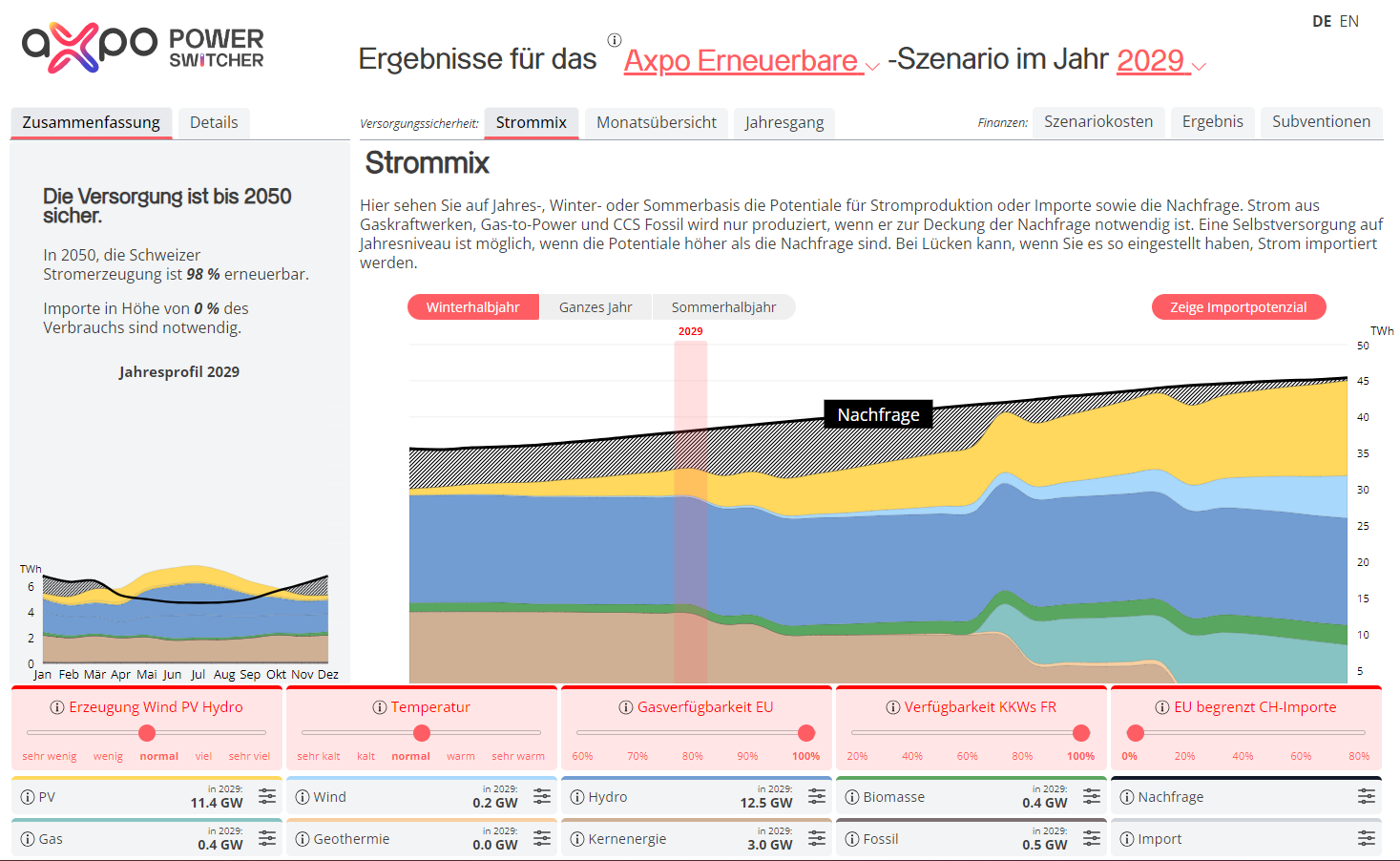15.06.2021 | Energy transition study by the ETH Lausanne – political framework conditions important
Green power mix from Switzerland
Switzerland is already forced to import power during the winter months. When the climate-friendly nuclear power plants are shut down after an operating time of around 60 years, this gap will become even larger. Hydropower with a mix of solar, and mainly wind energy in the mountains, could optimally cover this shortage in Swiss power production. These are the findings of a study by the ETH Lausanne (EPFL). In addition, the political framework conditions must enable the expansion of renewable energies, says Axpo.
Switzerland is already forced to import power from abroad during the winter months (see graphic below). When the plug is pulled on nuclear power plants, an even bigger production gap will occur in Switzerland, especially during the cold months.
A study published in "Environmental Research Letters" indicates that the shortage could be covered with sun and wind energy – if the plants are installed at clever locations. Accordingly, a share of 75 per cent from wind power and 25 per cent from solar energy would supplement current supply from hydropower production. Researchers at the Federal Institute of Technology Lausanne (EPFL) and the Institute for Snow and Avalanche Research (SLF) come to this conclusion. At least, that's how an "optimal scenario" would look.
For the study, researchers developed a method to play out various scenarios on how a power mix with renewable energies could be designed so that it is as CO2-neutral and independent from foreign imports as possible.
Sunny, windy mountains
Their optimal scenario correlates to a high proportion of wind power in mountainous regions where there are strong winds. According to the model, the Jura mountains have a lot of hidden potential: 40 per cent of the recommended installations can be attributed to this region, followed by the Alps and Prealps.
According to the study, solar energy offers good, financially viable opportunities, especially in the Alps. During the winter these areas have a great deal of sun, says Michael Lehning, who works at the Laboratory for Cryosphere Research at the SLF and the EPFL. "And the existing power grid, which is mainly fed with hydropower, could be used to transport this energy to the lowlands." This would reduce reliance on energy from neighbouring countries by 80 per cent during the winter, says the scientist. That is precisely why Axpo and IWB are building the largest alpine solar plant, AlpinSolar, on the Muttsee dam at an altitude of 2500 m.a.s.l. this summer.
Expansion in cities unfeasible
The often touted idea to install solar modules on rooftops in Swiss cities on a large scale is not feasible according to calculations made by the researchers, mainly because there is too little sunshine in the lowlands during the winter.
With a clever synergy of sun and wind energy, as well as hydropower, no additional seasonal storage would be necessary according to the study. Furthermore, Switzerland would be less reliant on imports from abroad, in particular in times when many neighbouring countries also faced with surpluses and deficits in power production.
The team used geographical models for the simulations in order to maintain minimum distances between new wind power plants and residential housing, and to avoid glaciers, the National Park and – in the case of solar plants – slopes facing north. Weather data, the current hydropower infrastructure, and Swissgrid's projected power grid for the year 2025 were also included in the calculations.
It's a provocative scenario, says the primary author and EPFL doctoral candidate, Jérôme Dujardin. "However, we wanted to think through our approach in order to point out the most efficient option even if it seems radical – well knowing that policy-makers will choose a middle course that lies between this scenario and the current situation."
Axpo as a driving force in the energy transition
Axpo has expanded its position as the largest Swiss producer of renewable energies in recent years, especially abroad. Our strategy foresees a very ambitious expansion of renewables there. In the solar area, for example, we want to increase the portfolio by 10 GW by the year 2030 – about 20 times more than today. The target for wind power is an ambitious 3 GW of additional capacity.
Axpo also wants to play a leading role as a driving force for the energy transition in Switzerland and for the expansion of solar energy. However, Axpo CEO Christoph Brand notes: "Unfortunately the current regulatory framework conditions are such that large plants cannot be feasibly realised. This also holds true for hydropower. Despite increasing power prices and good price outlooks in the medium term, investments in hydropower are not profitable. This also applies to investments in upgrading and the augmentation of production in existing power plants. This summer, policy-makers have it in their hands to set the right course for Switzerland when they deal with the revision of the Energy Act and the Electricity Supply Act."




.jpg)





